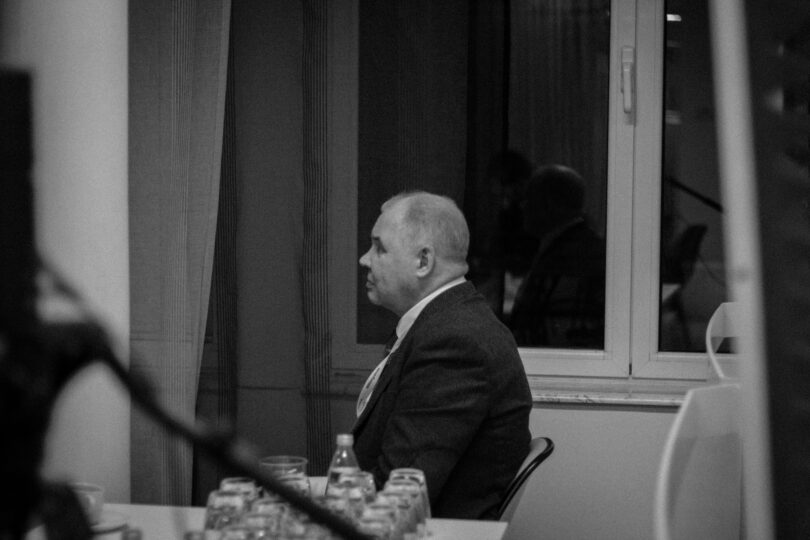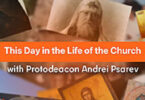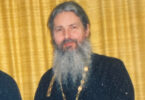Prof. Andrei Vladimirovich Popov has a unique place in the historical community. He is compiling something that is essential to all historical research – a thematic bibliography – of articles and books on topics relating to the Russian Church Abroad. Prof. Popov stands for a time when everything linked to the Russian diaspora is increasingly the subject of research in contemporary Russia – on which the same diaspora has had varying and ambivalent views – rather than in other countries.
Prof. Popov was born into a military family in Poland in 1962 and later served in the army himself. In 1989, he was demobilized and was admitted to the Moscow State Institute for History and Archives. In 1997, he completed the graduate program of the Institute for History and Archives of the Russian State University of the Humanities. The following year, under the supervision of Prof. Evgenii Starostin, he defended his Candidate of Science dissertation on “Russian Émigré Documents in Moscow Archives. Problems of Discovery, Compilation, Description, and Use”.
Prof. Popov has been teaching for over 25 years in the Institute for History and Archives and is the creator of the first Master’s degree program in Russia on the History of the Russian Orthodox Church. His connections with the Russian emigration are not only theoretical but also personal: his godfather is the Church historian Vladimir Stepanovich Stepanov (Rusak, 1949-2019).
Work on our interview with Andrei Popov began in 2010. In 2014, we received answers. However, they needed to be clarified in person. Now, finally, on January 24, 2020, we were able to meet in Moscow and wrap up the interview. The interview is a continuation of the conversation on ROCOR’s historiography begun by a 2010 interview with A. L. Gurevich, the creator of an electronic database of religious leaders of the Russian emigration, and Viktor Kosik, the author of a collection of clergy biographies.
This translation by Walker R. Thompson has been made possible by a generous grant from the American Russian Aid Association – Otrada, Inc.
Deacon Andrei Psarev,
February 10, 2020, Jordanville, New York
Please tell us how you began compiling a bibliography on the history of the ROCOR.
When I was working on a book on the history of the Russian Church Abroad, I came across a large amount of literature. It is only natural that I compiled a list of sources. When this list became very large and came to include over 2,000 bibliographical records, there emerged a need to structure it. And from then on the list, or indeed bibliography kept growing and has now exceeded 10,000 bibliographical records. The structure changed, as well; it too grew, became more complicated. My dear Fr. Andrei, I will say something more: I have grown so used to this list that, in recent years, there has not been one day when I have not added something to it. When a new publication comes out or I read something interesting on this subject, I always add it to the bibliography without fail, even though I myself do not know why. For fairness’ sake, it ought to be said that I have succeeded in publishing it.
I have grown so used to this list that, in recent years, there has not been one day when I have not added something to it. When a new publication comes out or I read something interesting on this subject, I always add it to the bibliography without fail, even though I myself do not know why. For fairness’ sake, it ought to be said that I have succeeded in publishing it.
Please tell us about your 2005 monograph with a systematic bibliography, “The Russian Orthodox Diaspora: History and Sources”.
This monograph is about the Russian Orthodox diaspora and its place in the history of Russia. It is centrally focused on the development of the canonical and ecclesiastical administrative position of the part of the Russian Orthodox Church situated outside of Russia following the 1917 Revolution and the Russian Civil War. One of my tasks was to analyze the contemporary state of the Russian Orthodox diaspora and to search for an answer to the question of whether a reunion of the Russian Orthodox Church (Moscow Patriarchate) and the Russian Orthodox Church Outside of Russia was possible.
The work consists of an introduction, six chapters, a conclusion, and appendices. The first chapter gives an overview of published sources. Special attention is paid to the analysis of church periodicals and memoirs. The second chapter is on the archival records of the Russian Orthodox diaspora kept in Russian and foreign repositories. The third chapter examines the history of the Russian Orthodox diaspora prior to 1917. The fourth chapter contains a history of the Russian Orthodox Church during the 1917 revolution and the Russian Civil War. The fifth chapter is about Decree No. 362 of November 7/20, 1920, and its significance for the Russian Orthodox Church Abroad. The sixth chapter contains a brief sketch of the history of the establishment and development of the Russian Orthodox Church Abroad and of other Russian Orthodox ecclesiastical jurisdictions.
In the appendix, a report of St. John of Shanghai “On the Spiritual State of the Russian People in the Diaspora” is published along with the text of a talk by Metropolitan Damaskin of Switzerland at a session of the Inter-Orthodox Preparatory Commission at Chambésy (November 7-13, 1993) and a timeline of the most important dates in the history of the Russian Orthodox diaspora.
Your monograph was published in 2005. Was it followed by another volume?
The next volume was published in 2007 as part of a series of materials on the Russian political emigration, as Rossiskoe pravoslavie za rubezhom: bibliograficheskii ukazatel’ literatury i istochnikov 1918-2008 g. (Russian Orthodoxy Abroad: A Bibliography of Literature and Sources, 1918-2008). Why was it published in this series? One does not always want to link the church and politics, but vanity compelled me to do so.
Are you the author of this series?
Yes. All the volumes are about (more or less political) émigrés, including Nikolai Aleksandrovich Troitskii, Father Dimitrii Konstantinov. The 12th volume in this series, which came out in 2007, supplied a bibliography. It took years to put together, because I attempted to systematize everything that I read or encountered in libraries, and so on. Therefore the list kept growing and became quite large. The volume in question contains 8110 entries on topics ranging from the Russian Ecclesiastical Mission in Korea to the ROC during the Second World War.
Andrei Vladimirovich, when you make an inventory of articles, what principles do you follow? There are thousands of articles stemming from the Russian diaspora on the history of the Russian Church Abroad, yet you do not simply scan all of these articles as if you were a scanner. What criteria do you use during the process of compilation?
In general, I love bibliography – not even in the sense of an academic discipline or a science. I always have a lot of bibliographical lists, indices. Let us take one such topic, for example: Russian archives abroad. I collect everything that has to do with these archives. The list starts growing: at first there were 200 entries, then there come to be one thousand, two thousand. It needs to be classified, systematized. Certain subdivisions emerge. First comes the simplest division of all, that according to the type of material. For instance, books or articles. It helps even to divide your list into two parts. That’s already something. And then what comes next is narrower… For example, things related to Russian Orthodoxy in history, and those related to the history of Orthodoxy in general. The fact of the matter is that in the history of the Russian Orthodox Church, you find all the same things as in the history of Russia in general. All the same classifications, topics. And indeed not only in the history of Russia, but in history overall, since there is also church archaeology, church architecture, and church art, which includes the architecture of Orthodox churches, iconography, decorative arts…
Please tell us about what is involved in your research on the Russian Orthodox Church Outside of Russia.
My research involves putting together articles and books on the history of Russian Orthodoxy abroad and its archival records. Preparing reference manuals and guides to the archives of the Russian Orthodox Church. Also, working in the Institute for History and Archives of the Russian State University of the Humanities, where I give lectures on the history of the Russian Orthodox Church Outside of Russia, the Archives of the Russian Orthodox Church in Russia, the Archives of the Russian Orthodox Church Abroad, Problems of Russian Archives Abroad, the Russian Legacy in France, the Documentary Legacy of the Russian Emigration, and so on.
What do you find attractive and off-putting in the history of the Russian Church Abroad?
What I find attractive is its faithfulness to the Orthodox faith, faithfulness to tradition, and love for Russia. As for what is off-putting – nothing is off-putting. One can sometimes regret a certain inability to make compromises and, very often, the prevalence of political principles over what is Christian and spiritual.
In my view, there is nothing in Decree No. 362 that would provide any canonical or other basis for the existence of the Supreme Church Governance of the Church Abroad, the Synod of Bishops of the Church Abroad, or the ROCOR subsequently.
You have come to the conclusion that Decree No. 362 does not apply to the Russian Church Abroad. What is your justification for this?
I have based this view]on an attentive reading and analysis of Decree No. 362 of November 7/20, 1920, as well as on an analysis of its interpretation by authors inside and outside of Russia.
It ought to be noted that when they initially organized two consecutive forms of church governance, the Russian bishops abroad did not offer any canonical justifications and used Decree No. 362 only to dissolve the last governing body of the Church Abroad [in 1922]. In actual fact, the governance of the Church Abroad did not refer to Patriarch Tikhon’s Ukaze (Decree) No. 362, nor did it ever have any connection with it, neither when its “prototype” in the South of Russia was established, nor in the “Constantinople” or “Karlovtsy” periods. This is confirmed by documents of the First All-Diaspora Council (Assembly) of 1921, in which there is no mention whatsoever of Decree No. 362. The Nakaze to the Assembly of the Russian Church Abroad reads: “The Russian Church Abroad ought to act on the basis of the word of God and the holy canons of the Church and, keeping in mind the atypical situation of the Russian Church outside of Russia, to aim to meet the actual needs of the church in its current situation, while acting with the knowledge and blessing of His Holiness the Patriarch of Serbia and conforming its activities with the canonical jurisdiction of the Patriarchate of Serbia.” In my view, there is nothing in Decree No. 362 that would provide any canonical or other basis for the existence of the Supreme Church Governance of the Church Abroad, the Synod of Bishops of the Church Abroad, or the ROCOR subsequently. Authors who are supporters of the perfect canonicity of the Church Abroad on the basis of Decree No. 362, often endue this decree with a canonical force and equate it with canon law. It is doubtless the case that this Decree has canonical force, since His Holiness the Patriarch, the Holy Synod, and the Supreme Church Council did not exceed their prerogatives in adopting Decree No. 362, and did not violate any of the Apostolic Canons or the canons and decrees of the Ecumenical and Local Councils. In this sense, the Decree is canonical, though this does not mean that it is an article of canon law and much less so a canon.
In actual fact, Patriarch Tikhon’s Decree of November 7/20, 1920, did not have any relation to the emigration: it concerned only diocesan bishops who remained in their legitimate canonical sees with their ordinary pastoral responsibilities. (For more on the topic, see: Popov, Andrei Vladimirovich. Rossiiskoe pravoslavnoe zarubezh’e: Istoriia i istochniki. S prilozheniem sistematicheskoi bibliografii [The Russian Orthodox Diaspora. History and Sources, Including a Systematic Bibliography]. Moscow, 2005, pp. 209-236.)
My view on Decree No. 362 has been informed and altered to a certain degree by that of the very same Vladimir Stepanovich Rusak, which is in principle in agreement with my own. Yet I do not think that, had it not been for his view, my own would have changed, since this is something that is very difficult to disprove. Vladimir Stepanovich, for his part, analyzed this degree several times and said that there was no basis for any other interpretation or understanding of it.
It seems to me that the fact that it says “etc.”, “movement of the front”… that here we have some kind of extreme circumstances in this vein, or that the Patriarch is generally dealing with completely unpredictable situations. This thought was expressed by Fr. Nikolai Artemov and in general, a consensus has formed on how this decree might be applied to the ROCOR. Therefore, your position is especially interesting to me.
It is difficult to imagine that Patriarch Tikhon could have been thinking of any kind of foreign parts, that Russian Orthodox people might come and begin sowing some kind of discord in Serbia, Egypt, Jerusalem, Japan, or America.
There are two other issues here: the fact that the Decree was issued on November 20, 1920, that is, after the end of the Civil War in European Russia. Also, in the Acts of Patriarch Tikhon, published in 1994, there are minutes of an interrogation where it is alleged that Patriarch Tikhon gave a blessing to the Russian bishops in Constantinople. From what you are saying, I don’t understand what he had in mind and what was being implied there.
I think the simplest explanation is that he was not planning anything with far-reaching consequences. He merely gave his blessing. Thus there was all the more reason for these bishops to consult the Patriarch of Constantinople on whether they could remain there and what they could do. And Constantinople gave them very limiting instructions: “no more than…” And no more. They replied saying “thank you” and that was it.
Vladimir Stepanovich noted that they did not behave very well, because when they departed from Constantinople, they did not even inform the Ecumenical Patriarchate, even though they could have said: “Thank you for your small measure of hospitality and for what you have given us. Now we are leaving.” And the Patriarch of Constantinople would have replied in the same vein. Patriarch Tikhon would have said, “I give you my blessing.”
The Ecumenical Throne simply counted them as its own. The fact that he gave them these rights… and that within the Ecumenical Patriarchate. But this blessing to establish an autonomous church structure within the Patriarchate of Constantinople later came to be interpreted as though it gave them the right to some kind of independent existence.
What are you working on now?
On the one hand, I have my teaching load. In February 2014, we managed to establish a Master’s degree on “The History of the Russian Orthodox Church” at the Russian State University of the Humanities. To this end, I had to work to prepare dozens of documents and sets of teaching materials. I am continuing to teach on the topic of Russian archival documents. As it happens, a textbook was published in our Institute in 2019 on Russian Documents in Foreign and Russian Archives. There is a large chapter in it on the archival heritage of the Orthodox church.
That is to say that the topic of the Russian Church in the emigration remains one of your top priorities?
It cannot be any other way. Even if I did not want it to be, it is inevitable for reasons that do not depend on me, since I am, after all, the head of the Master’s degree in the History of the Russian Orthodox Church.
Well, you could say: “of the Russian Orthodox in the homeland”. But you…
The thing is that I draw up plans for courses and all the rest. Among other things, I have to teach between 15-20 disciplines, because we do not have such a huge faculty. Apart from the history of the Russian Orthodox Church, I have included the history of the Russian Orthodox Church Outside of Russia as part of our program, or indeed, more broadly, the history of Russian Orthodoxy abroad. Plus we have the mandatory course on “The Archives of the Russian Orthodox Church”, and there exists a parallel course on “The Archives of the Russian Orthodox Church Abroad”. We have a course on “Monasteries and the History of Russian Monasticism and Monasteries”. There is a parallel course that did not exist in any other Master’s programs, “The History of Monasticism and Monasteries Abroad,” since no-one else thought of it. There is also a course on “The Architecture of Orthodox Churches”, and, indeed, a course on “The Architecture of Orthodox Churches Abroad”. The same goes for church art. This is because such parallel courses could not exist in any other Master’s or Bachelor’s program. Not in the Moscow or Saint Petersburg Theological Academies, nor in any others has anyone ever… There has always been a course on “The History of the Russian Orthodox Church”. But no-one would have ever added such an additional course with so many hours on the history of the Russian Orthodox Church Abroad. The same applies to art or monasticism, and so on. Therefore, as long as we have this Master’s program, and we have had it for 5 years, since 2015… this Master’s degree, it existed before. It was begun in 1995, when our head of department, Prof. Evgenii Vasilievich Starostin, created a major that did not take into account Russian Orthodoxy abroad. It was called “The History of the Russian Orthodox Church”. Vladimir Stepanovich Rusak participated in this venture and taught several courses. But then 20 years passed and this major was terminated when we established the Master’s. Twenty years later. We had been moving slowly towards this. What is more, in this Master’s degree, I do not have any helpers or secretaries. No-one. I am alone. I do not have any helpers, anyone. And then there are the people, and the tuition process, and the curriculum… and it is just me. And each year we have to attract applicants. That is also not easy.
With which researchers from the Russian Church Abroad do you collaborate?
I collaborate in the first instance with my good friends Viktor Ivanovich Kosik and Aleksandr Alekseevich Kornilov, and hold in reverence the memory of my godfather, Vladimir Stepanovich Rusak, and that of my teacher Prof. Starostin, who was the first to raise the issue of the need to preserve the archival heritage of the Russian Orthodox Church, to study the archives of the Russian Orthodox Church, and to produce a large number of works on these issues. I also collaborate with Svetlana Sergeevna Levoshko, a well-known Saint Petersburg researcher on the history of Orthodox church-building, Russian architecture abroad, and an expert on the architecture and symbolism of Orthodox churches.
Andrei Vladimirovich, do you have any colleagues who are doing similar things, compiling bibliographies? I do not know anyone myself. I do not know another Popov in Russia. In my view, there is no-one.
There is no-one else in the Russian State University of the Humanities. Yet library employees have to do just this as part of their work. If we are talking about the whole Russia, then the Russian State Library (RSL) is responsible for bibliographical work. The Russian State Library is responsible, among other things, for developing bibliographical standards. The Russian National Library also does this.
But in the RSL they closed the department on the Russian diaspora, which was headed up by Nadezhda Vasil’evna Ryzhak.
Nadezhda Vasil’evna herself did not do any bibliographical work. She did an excellent job, since this department grew out of the former special collections of the RSL, which were located at the very top. And Nadezhda Vasil’evna has continued to work on this. Yet she has not been doing so much bibliographical work, but rather has been working on the history of the Russian diaspora. She always takes part in conferences on the history of the Russian diaspora, and so on.











